- How to Prepare for Your Motorcycle Road Test
- Tips for test day, before your test begins
- Overview of the test
- The Test.
How to Prepare for Your ICBC Motorcycle Road Test
Getting your motorcycle license in BC is a straightforward process.
Step 1: Pass your knowledge test.
Step 2: Pass your parking lot test.
Step 3: Pass your road test.
This article is about Step 3 – how to pass your ICBC class 6 or class 8 motorcycle road test.
Passing your road test on a motorcycle is simpler than most people think. But only if you prepare!
The road test isn’t about your skills as a rider (although, you should definitely be capable of handling a motorcycle safely before attempting your road test). There are 3 essential elements to your class 6 road test and the one that is most directly in your control is your HABITS.
‘Seat time’ is good, getting comfortable on your motorcycle is good, practice is good, but as the old adage “Practice makes perfect” was changed in recent times to “Perfect Practice makes Perfect”, you want to practice correct habits. If you simply practice without knowing what to practice, you aren’t likely to pass your road test.
This article was created to help Urban Rider Motorcycle School students prepare for their road test. It is required reading before the Road Test Practice Session (a 75 minute road test practice run on the streets of Burnaby, including a 45 minute mock test, post session review and video of the entire lesson ).
I mentioned that there are 3 essential elements. They are 1) Habits 2) Knowledge (rules of the road) and 3) Confidence. Good habits, however, can overcome a lack of confidence to some degree, but confidence can’t overcome bad habits on the ICBC road test. The next section is about the habits that will be marked on the road test, but continue reading to learn more about how a lack of confidence can be marked on the road test.
The 5 Marking Categories
The 5 general marking categories on the ICBC motorcycle road test can be found in the Learn to Ride Smart book that you used to prepare for the knowledge test. Remember the See – Think – Do strategy for safe riding found on page 67? Observation is the ‘See’ part. The other 4 markable actions make up the ‘Do’ part of See – Think – Do.
- Observation
- Speed Control
- Communication
- Space Margins
- Steering
Scroll down to Part 4 to learn more about the specific actions that will be marked in these 5 categories.
2. Test Day Readiness
On test day, arrive early. Your check-in time is 15 minutes before your test, but there may be a line-up, or traffic en route. Show up early enough that you won’t increase your stress unnecessarily, but not so early that you are sitting around thinking about everything that can go wrong on your motorcycle road test! If you are more than 15 minutes early, take a ride around the testing location and familiarize yourself with the entrances and exits and the streets directly adjacent to your testing center.
Also, make sure that your bike is safe for the road. All signals, lights and horn must be working, and there should be no visible signs that the bike is unsafe, such as severely worn out tires.
Need a bike for your road test? Our Motorcycle Road Test Prep Package includes 2 x 75 minute lessons, and use of a motorcycle for your road test.
Don’t forget…
- 2 pieces of ID – What counts as accepted ID?
- Payment
- Motorcycle Insurance Documents (or a photo of the documents, or at the least, a photo of your license plate showing the plate number and expiration date)
3. Overview of the Road Test
Check in at the road test check-in counter. There is often a line-up outside of ICBC. At the testing center in Burnaby, where Urban Rider Motorcycle School students test (Vancouver doesn’t offer motorcycle road testing), the line-up that is outside is only for people without an appointment. Read the signs at the front door and follow the appropriate line (a green line painted on the ground) to the queue inside ICBC with a small sign that says “Road Test Line-up”.
When checking in, you will be asked for your motorcycle insurance documents, or a photograph of your license plate. You will also be asked where you are parked. In Burnaby, there is a marked area for motorcycles in the south-west corner of the parking lot (directly across the parking lot from the front doors of the building). After checking in, you will be directed to wait near your motorbike for the examiner.
There will be two ICBC employees involved in your motorcycle test – a driver, and an examiner. Often the driver will approach you first and give you the vest, as they usually arrive at the testing vehicle ahead of the examiner. The vest has a radio in the back pocket and a speaker/mic that is attached to the radio by cable, and securely fastened to the shoulder of the vest. Make sure that when you put the vest on, it is secure. Pull the velcro straps tight, as the radio speaker is fairly heavy and gravity can pull the speaker off your shoulder to a lower position where it is more difficult to hear.
The examiner will approach you and introduce themselves when they are ready to begin. It has been my observation that most examiners seem to enjoy the motorcycle testing and will generally be quite friendly with the rider. The first order of business is explaining to you how the test will be conducted. They will typically tell you how the radio communications work and that you should tap your helmet if you need them to repeat the instructions. Most of their instructions are simply “turn left at the intersection” or “turn right at the intersection”. They will explain to you what to do if you get separated or lost, but this rarely happens.
The examiner will ask you to demonstrate that your lights and horn work, so make sure that you test them ahead of time. You may not be permitted to test if your bike is deemed unsafe because of a burnt out brake light, or malfunctioning horn. Any modifications to the bike, such as a rear fender eliminator kit, or integrated turn signals will be assessed for safety. Many modifications that people make to their motorcycles are not legal and can result in a ticket if inspected by a traffic officer, however the ICBC road test examiner is primarily concerned with whether or not the modification makes the bike unsafe (for example, by making it virtually impossible to see your that your turn signal is on).
The examiner will ask you to demonstrate that you know your hand signals (left, right, slow/stop). All hand signals are done with the left arm. You are not being marked on this, and the examiner will demonstrate if necessary, but show your readiness for the test by brushing up on these three hand signals ahead of time.
After conducting a readiness check, the examiner will test the radio and then get into a vehicle which will follow behind you throughout the test.
4. Skills are marked in the following categories
Speed Control
- Try to stay within 5km/hr of the speed limit when possible. If other vehicles are speeding, don’t go with the flow of traffic, but don’t go too slow either.
- Yellow speed signs vs white speed signs: Yellow signs are cautionary, you are not required to obey them, unless circumstances suggest that the posted speed is a safe speed. White signs show mandatory speed limits. On main streets, don’t go more than 5km/h over a posted speed on a white sign. If the white sign says ’30’, stay between 25 and 30km/h.
- Try to maintain the speed limit unless there a reason not to, such as a side street with limited visibility or traction issues, where 50 might be unsafe. Did you know that you can get demerits for going too slow? Don’t go more than 5km/h under the posted speed limit without a reason.
- Highway merge – get up to speed before you merge. Show your confidence. On a freeway entrance lane, you are permitted to go whatever speed is necessary to merge safely. So if the speed limit on the freeway is 90, but the traffic is moving at 110, it is ok to go 110 when merging. Just remember to slow down to the speed limit (within 5 km/h) once on the freeway.
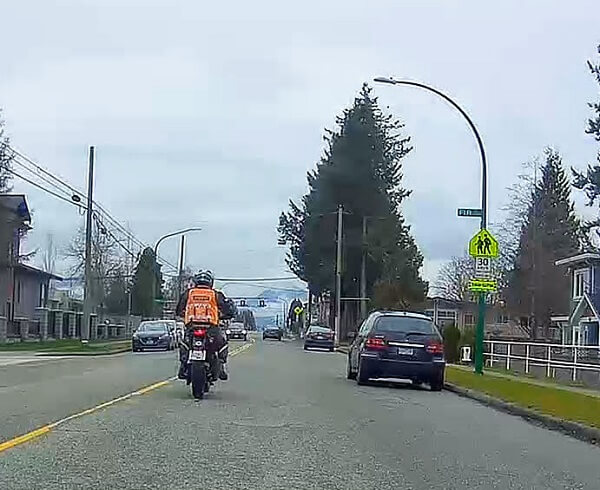
Communication
- Use your turn signals ahead of your action, to give other road users advance warning of your intentions, but not so early that it confuses other drivers and pedestrians. Typically you want to use your signal at least 2 to 3 seconds before changing lanes or turning.
- Cancel your turn signals immediately after turning. For the road test, make sure it is cancelled within 3 seconds of completing your turn or lane change.
- Don’t signal if you are just changing lane position; for example, moving from position 1 in the right lane to position 3.
- Approaching an intersection with your turn signal on, when the examiner has not asked you to turn could result in a verbal warning (examiner tells you through the speaker to cancel your signal in order to keep you safe) and possible failure*.
*This would most likely be the case if there was a vehicle on the other side of the intersection facing you, waiting for a safe opportunity to turn left in front of you. If your signal is on, the driver of the other vehicle may decide to turn in front of you, so make sure your signal is off in these situations by repeatedly pressing the turn signal cancel button.
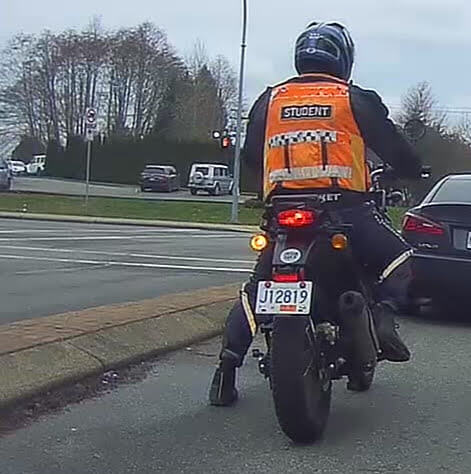
Observation
- This is based on the movement of your helmet
- Scanning
- When approaching an intersection that has visual obstructions, move your head a little to the left and right as you approach. It isn’t enough to scan with your eyes (the examiner can’t see your eyes move!), so turn your head/helmet, just enough that they can see you scanned.
- If you are leaving a stop sign, or were the first vehicle stopped at a red light, when the light turns green do a quick scan left and right before moving off.
- Shoulder Checks
- Any time that you move your motorcycle to the left or right, move your head in that direction before moving the motorcycle. You are checking your blind spot – just behind you and slightly to the side of the motorcycle. This check requires that you turn your head about 1/8 of a turn (45 degrees, to 1:30 on a clock face).
- Deep check over right shoulder.
- When asked to turn right on your road test, if you must stop before making the turn, determine if it is safe to go, and then do a deep check for cyclists over your right shoulder before moving off. This is perhaps the most common mark on the road test, so be consistent.
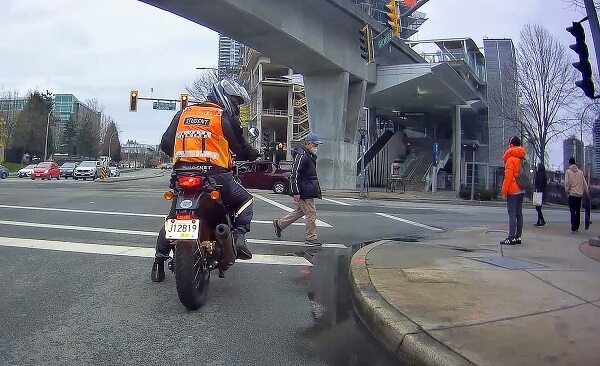
Space Margins
- 2 seconds is the minimum following distance. 3 seconds if the vehicle in front of you is a bus or large truck that blocks your view of the road ahead.
- 3 to 4 meters between you and the vehicle in front of you, when you come to a stop in traffic.
- 1-2 meters between you and other road users/objects around you. This would include parked cars, moving vehicles, sign posts, cyclists etc. A minimum of 1 meter is required during the test, but it is best to maintain a little more than the minimum when possible.
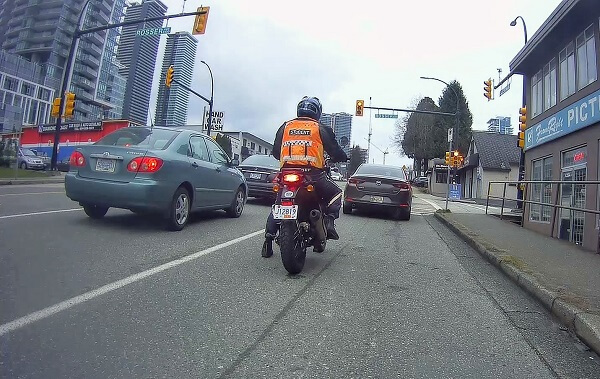
Steering
- Make smooth left and right turns.
- Don’t cut your corners.
- U-turn on a side street – try to complete it without putting your foot down, but the main points to remember are that you don’t hit the curb or ride over someone’s lawn, and that you check for approaching vehicles before beginning your u-turn. Also, remember to signal!
- Keep your feet on the foot pegs when the motorbike is moving. If you hang your feet as you leave a stop sign, expect to get demerits. Some riders create the habit of hanging at least one foot as the approach a stop. Avoid this. Keep your feet on the pegs while the bike is moving and only remove your foot/feet as you come to a stop and need to put your foot down in order to keep the bike from falling over!
Side note: When I train riders in the parking lot, I always ask them to keep their right foot on the peg at all times. This helps to create balance and also ensures that they are capable of doing a hill start (the right foot holds down the rear brake) without rolling back. But on the street, and during your road test, if you need to put the right foot down when you stop, or both feet, there is nothing wrong with that. You won’t get demerits for putting your right foot (or both feet) down, as long as your feet don’t come off the pegs until the bike is coming to a stop.
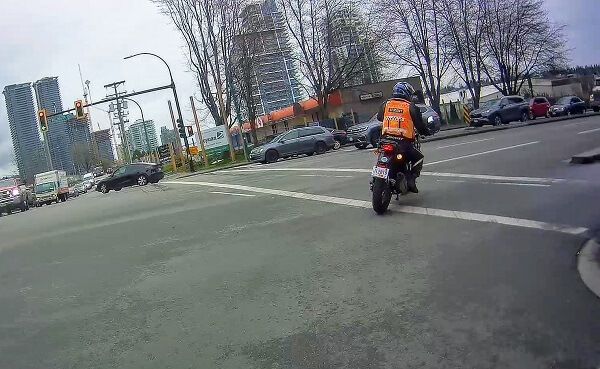
FAQ – Frequently Asked Questions
Do you have a question? Email us at urbanridermoto@gmail.com
#1 Most Frequently Asked Question:
Do ICBC examiners have a quota, a number of people that they must fail each day?
Answer: Absolutely NOT! This is a common misperception. Many skilled riders fail the test on their first try as they have bad habits that they aren’t aware of. And many inexperienced riders fail multiple times. This gives the impression to many people that the road test examiners have a quota.
Now, I don’t have ears in the morning meetings at the ICBC road test office, but I can say with certainty, after 7 years of coaching riders to pass the road test, that the riders who go in to the test well prepared are 95% likely to pass. When an Urban Rider student fails and returns to see me after their test with the marking sheet, the result is seldom a surprise.
For example, as of the date of this writing on March 25th, we have had 20 students test at ICBC in the first 3 months of 2022, with 19 passes and 1 failure. The student who failed had 10 years of riding experience in another country, and was a skilled rider, but had created several bad habits. Those habits were identified during the first videotaped lesson. After watching the video, the rider returned for a second lesson and showed that they had fixed all but one of the bad habits. The student was aware before the road test that if they didn’t fix that habit, it could affect the outcome of their test. The only mark they received on their test was for that one bad habit that had been identified in advance, but they repeated it too many times and it cost them the test.
The good news is, that the rider came back for a third lesson, focused on that one habit, and then passed the road test easily, 5 weeks after their failed attempt.
Years of experience doesn’t help, if you have created bad habits and repeated them for years. My advice to riders is to book the earliest road test available, and then make each ride before the road test, an opportunity to create good habits. Every time that you get on your bike, ride as if the examiner was behind you and on the day of your road test, there will be no need to stress!
The habits that are marked are clearly set out in the Learn to Ride Smart book provided by ICBC. Read the section on See – Think – Do, outlining OBSERVATION skills, SPEED CONTROL, COMMUNICATION, SPACING, and STEERING.
You may not agree with the examiner’s assessment, but rest assured that you are not being targeted. With a little coaching, anyone can pass the motorcycle road test. Nothing beats a trained set of eyes. Consider booking a road test prep class with Urban Rider if you are testing in Burnaby, or another school in your own city. It is best to train with a motorcycle riding school in the city where you will be taking your test.
